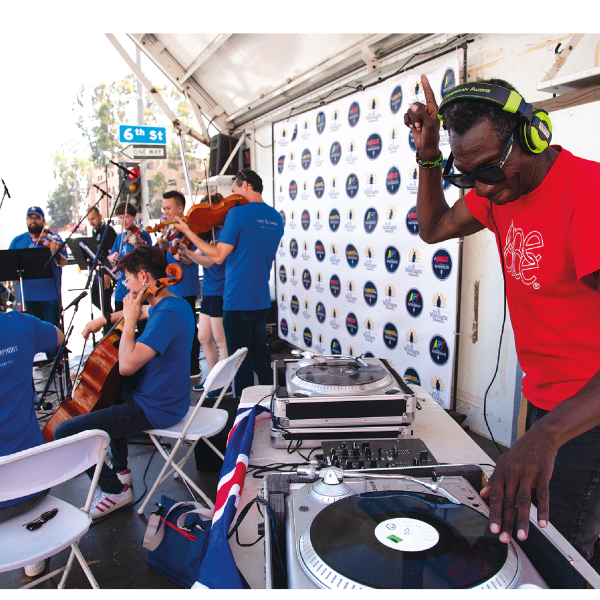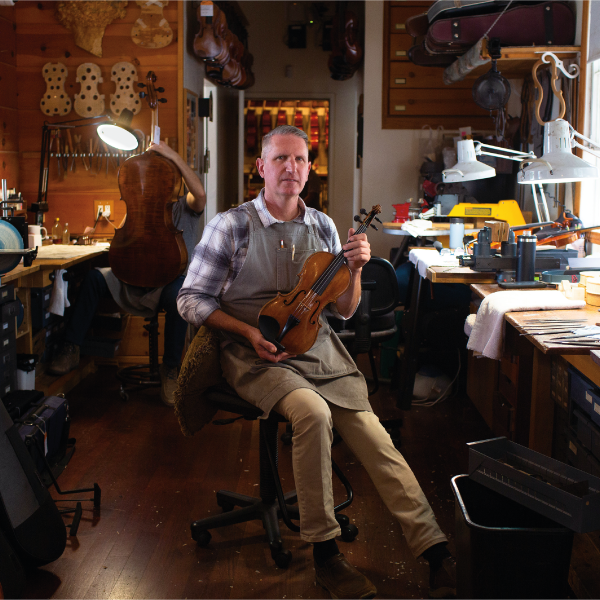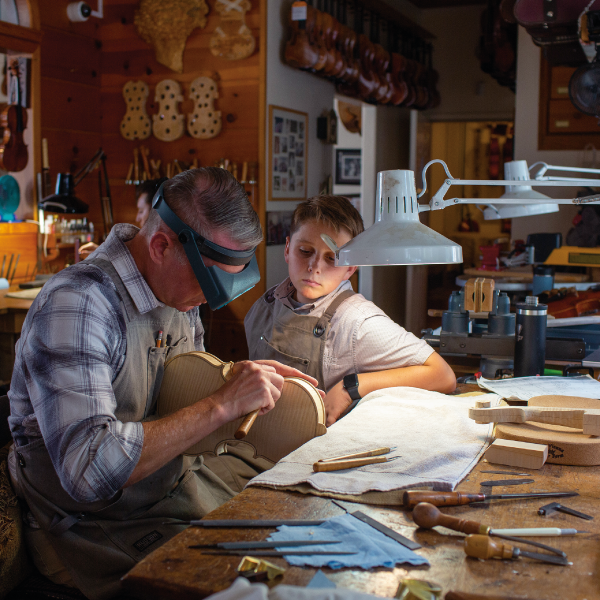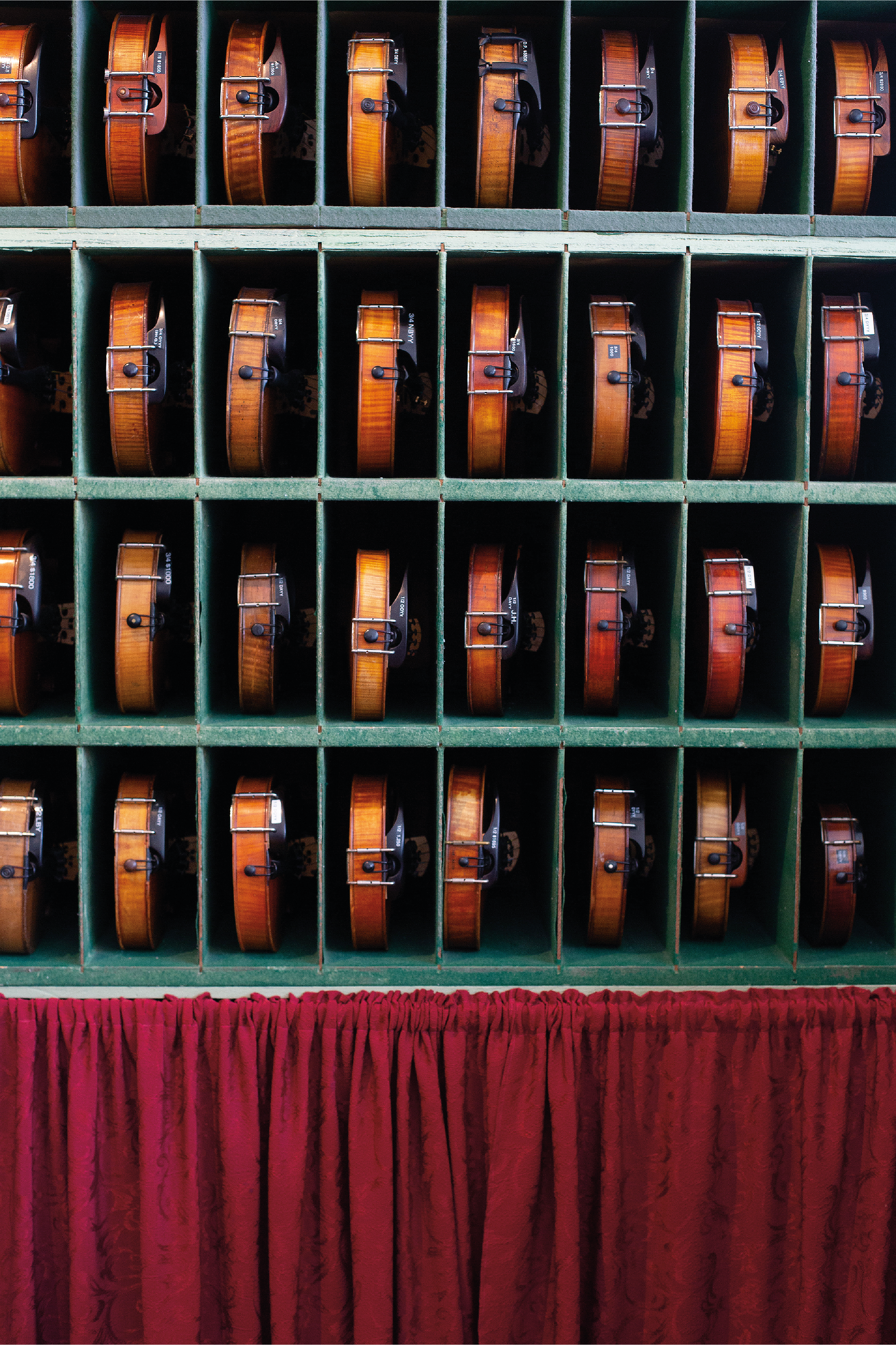In Tune
In Tune

DJ Sir Oliver mixes it up with Street Symphony players during a 2019 block party at the Midnight Mission in Los Angeles’s Skid Row. Photo by May Rigler.
When he was a 9-year-old boy studying at Juilliard, Vijay Gupta played 18th-century Italian violins borrowed from Machold Rare Violins, at that time the world leader in the historic string instrument trade. Gupta remembers Machold’s New York salon as something out of the court of Versailles: impressive, overwhelming, intimidating.
The same could be said of the instruments he was playing. “Machold had made a contract with my parents that when I was traveling around the world as a soloist and playing their violins, an adult had to carry the instrument,” he says. “So my dad was always carrying an instrument that was worth three times the price of our home.”
Gupta signed with the Los Angeles Philharmonic in 2007, when he was only 19 years old, and was a member of the orchestra’s first violin section for the next 12 years. Today he is the artistic director of Street Symphony, a nonprofit that he founded to bring free musical experiences to disenfranchised communities, including people across Los Angeles who are struggling with addiction and incarceration. He is also a cofounder of Skid Row Arts Alliance, a consortium that creates art for and with the nation’s largest homeless community. A 2018 John D. and Catherine T. MacArthur fellow, Gupta travels the world not only to perform and record but also to give talks on anything from the connection between music and mental health to the role music can play in social justice.
Along the way, Gupta has had the privilege of playing a number of exceptional violins: from the 2003 Krutz he used for his LA Phil audition, to a rare 1731 Domenico Montagnana that was loaned to him by the orchestra, to the priceless 1716 Stradivarius that legendary Ukrainian American violinist Nathan Milstein played for 40 years—an instrument so dear to Milstein’s heart that he renamed it the “Maria Teresa” after his wife and daughter.

Third-generation luthier Eric Benning inside Benning Violins, the family shop in Studio City, Los Angeles, which opened in 1953. Photo by James Bernal.
These were all incredible instruments, but Gupta says none of them resonated with him in a way that made him feel he had found his voice. That changed in February 2016, when he was invited to give a talk in Canada. At the time, Gupta was playing the LA Phil’s 1731 Montagnana, which was worth millions of dollars. He couldn’t risk damaging it in the colder northern weather.
Gupta asked a Los Angeles–based luthier and violin dealer named Eric Benning if he could borrow one of his violins for the trip. Benning offered Gupta a violin made in the style of 18th-century Italian luthier Carlo Bergonzi, which Benning had just finished making in 2015.
“I didn’t want to stop playing it,” Gupta says, smiling at the memory. “There was an immediate connection, like I was continuing the journey that Eric had started. It wasn’t a thing. It was a living, breathing creature, and I was now part of the process. Eric had finished carving the wood and painting the varnish, and now I was continuing the journey of that instrument into the world.”
Gupta’s connection to Benning’s violin resonated on more than a musical level. As his work with Street Symphony and Skid Row Arts Alliance shows, he is adamant that classical music is for everyone, not just people who can afford orchestra tickets. Benning’s parents—luthiers Hans and Nancy Benning—are of similar mind and in 2018 established the Benning Academy of Music Foundation, which funds music schools for disadvantaged youth and adults in Mexico.

Eric Benning works on a violin while his son Levi looks on. Photo by James Bernal.

Eric’s father, Hans Benning, met his wife, fellow luthier Nancy (formerly Toenniges), in Germany. Together they have run the shop for decades. Photo by James Bernal.
A third-generation luthier, Benning started making his first violin when he was 9 years old. “I studied with my folks, which is the natural progression in this business,” he says. In 1997 he went to Chicago to study with Carl Becker, his great-uncle, whom he credits with having a pivotal role in his understanding of how to make instruments. Over the course of his career, Benning has made more than 120 violins, violas, and cellos, completing 4 to 5 instruments a year.

As an instrument dealer—Benning Violins in Studio City is a family business—Benning doesn’t hold on to his violins. He wants them out in the world, being played. But he does collect bows, including one that was made for a violinist in Napoleon’s court. Gupta also purchased his bow, made in the 1840s by Jean Pierre Marie Persoit, from Benning Violins.
Benning uses a combination of old-school machine and hand tools to craft his instruments. Cellos are especially demanding to make. These days he can’t use a chisel for more than a half hour due to a work-related shoulder injury he sustained when he was younger. “Making instruments [requires] very concentrated effort in a very small form,” he explains. “So you are tense and you have to [remember] to relax at times and let stress off. But when you are young and you are strong, you can muscle through and all of a sudden you are like, Oh, why does that hurt?”
Benning purchases most of his tonewood—wood that possesses specific tonal qualities—from dealers in southern Germany. The wood has undergone a process that includes being felled and floated down a river to a woodcutter, who sometimes puts the logs under a sprinkler to control the rate of drying before cutting them. The boards then age for several more years before they are ready to be sold. The aim is to leave enough moisture in the wood to equal ambient moisture in order to prevent bowing, twisting, cupping, and splitting later. While many violin makers prefer tonewood that has seasoned for 5 to 10 years after being cut, Benning still stocks wood that his parents and grandfather purchased as far back as the 1940s.
Gupta purchased the 2015 Benning and played it for several years until a 2010 Benning Stradivarius model came up for sale and they did an even swap for the instruments. Benning still remembers the details of the 2010, which is made of Bosnian maple and Italian spruce that his grandfather had acquired in the 1940s. “As a maker, you look at wood and you just have a desire to make it. . . . You see something gorgeous and you’re just like, Oh, I want to see what that thing does,” he says of his decision to use those particular pieces.
Today, the 2010 Benning is Gupta’s primary violin. “It’s my Maria Teresa,” he says, adding that he and Benning have worked together frequently to refine the instrument, making tweaks to the sound post, which Benning says can affect the tone and responsiveness of an instrument. They have also made string changes and bridge and tailpiece adjustments.
“An artist’s voice is never found in a vacuum, ever,” Gupta explains. “It’s co-created. So my voice is as much Eric Benning’s voice as it is the voice of the room I’m playing in, and the people I’m playing for, and the audio engineer recording me.”
guptaviolin.com | @guptaviolin
benningviolins.com | @benningviolins

Vijay Gupta makes beautiful music on one of Benning’s lovingly crafted violins. Photo by Kat Bawden.







